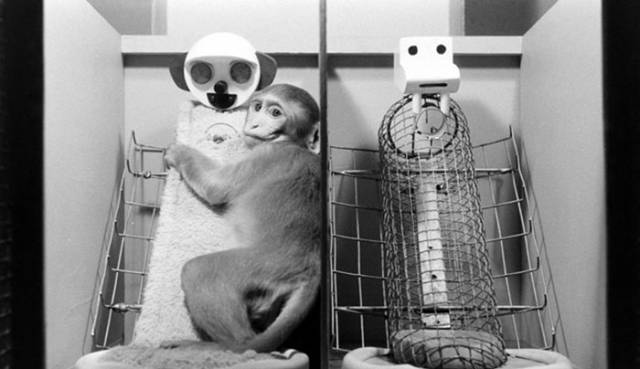Surrogate Mother Experiment

Harry Harlow, during the late 1950s and early 1960s, wanted to study the importance of a mother’s love for healthy childhood development. In order to do so he conducted a series of experiments on rhesus monkeys, observing how isolation and separation can affect the subjects in the latter years of their lives. Harlow’s Monkey experiment ultimately reinforced the importance of mother-and-child bonding.
Harlow separated infant monkeys from their biological mothers within 6 to 12 hours after being born. He then placed these infants in a nursery with inanimate ‘surrogate’ mothers – one who is made of heavy wire mesh and the other made of wood that was covered in soft cloth. Both surrogates were of the same size; however the wire mesh mother did not have any soft surface, while the cloth mother was soft to the touch and appeared to be cuddly.
In the first experiment, both the surrogates were placed with the infant monkeys, so the infants would have a ‘choice’ where to go. Both surrogates are able to provide nourishment to the infants. In the second experiment, the infant monkeys were divided into two groups (wire mesh or terry cloth), and the infants had no choice which one they would go to.
After observing the infant monkeys over time, it was found that even though the infants received nourishment from the wire mesh mother, they still spent more time cuddling and being affectionate with the terry cloth mother. This shows that the bond between mother and infant was not solely based on whether the former is able to give the latter’s physiological needs.
Furthermore, the results of the second experiment showed that while the infants from both groups consumed the same amount of milk from their mother, the infants who grew up with the terry cloth mother exhibited emotional attachment and what is considered as normal behaviour when presented with stressful variables. Whenever they felt threatened, they would come close to the terry cloth mother and cuddle with it until the monkeys were calm.
The results for the wire mesh mother were the opposite. They reacted rather differently with the same stimulus – throwing themselves on the floor, rocking back and forth, and evidently did not go to the wire mesh mother for comfort.